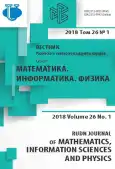Об одном методе оценки многомерной плотности на основеближайших соседей
- Авторы: Беляков Г.1
-
Учреждения:
- Университет Дикин
- Выпуск: Том 26, № 1 (2018)
- Страницы: 58-73
- Раздел: Математическое моделирование
- URL: https://journal-vniispk.ru/2658-4670/article/view/328295
- DOI: https://doi.org/10.22363/2312-9735-2018-26-1-58-73
- ID: 328295
Цитировать
Полный текст
Аннотация
Представлен метод оценки многомерной плотности, основанный на взвешенном методе ближайших соседей и имитирующий метод естественных соседей. Оценка многомерной плотности важна в машинном обучении, астрономии, биологии, физике и эконометрике.Строится 2-аддитивная нечёткая мера на основе аппроксимации индексов парных взаимодействий. Соседи, лежащие примерно в одном направлении, рассматриваются как излишние,и вклад дальнего соседа передаётся ближнему соседу. Расчёт локальной оценки плотности осуществляется с помощью дискретного интеграла Шоке таким образом, что учитывается вклад соседей, расположенных со всех сторон точки, где производятся вычисления. Однако вклад соседей, расположенных с одной и той же стороны, занижается с помощью выбора подходящей нечёткой меры. Таким образом вычисляется приближение к множеству естественных соседей Сибсона. Этот метод значительно снижает вычислительную нагрузку методов на базе естественных соседей, которые лежат на основе тесселяции Делоне, в высокой размерности, для которых вычислительная сложность растёт как экспонента раз-мерности. Описанный метод подходит для оценки плотности структурированных данных(возможно, лежащих на многообразии более низкой размерности), так как в этом случае ближайшие соседи могут значительно отличаться от естественных соседей.
Ключевые слова
Об авторах
Глеб Беляков
Университет Дикин
Автор, ответственный за переписку.
Email: gleb@deakin.edu.au
Беляков Глеб - профессор, кандидат физико-математических наук, профессор кафедры вычислительных технологий Университета Дикин, Австралия
Бурвуд хайвей 221, Бурвуд 3125, АвстралияСписок литературы
- D. W. Scott, Multivariate Density Estimation, John Wiley and Sons, New York, 2015.
- G. Beliakov, M. King, Density Based Fuzzy C-Means Clustering of Non-Convex Patterns, Europ. J. Oper. Res. 173 (2006) 717–728.
- P. Angelov, R. R. Yager, Density-Based Averaging — a New Operator for Data Fusion, Information Sciences 222 (2013) 163–174.
- G. Beliakov, T. Wilkin, On Some Properties of Weighted Averaging with Variable Weights, Information Sciences 281 (2014) 1–7.
- E. Parzen, On the Estimation of a Probability Density Function and the Mode, Annals of Math. Stats. 33 (1962) 1065–1076.
- C. Abraham, G. Biau, B. Cadre, Simple Estimation of the Mode of a Multivariate Density, The Canadian Journal of Statistics 31 (2003) 23–34.
- W. E. Schaap, R. van de Weygaert, Continuous Fields and Discrete Samples: Reconstruction Through Delaunay Tessellations, Astronomy and Astrophysics 363 (2000) L29–L32.
- E. Schubert, J. Sander, M. Ester, H. P. Kriegel, X. Xu, DBSCAN Revisited, Revisited: Why and How You Should (Still) Use DBSCAN, ACM Trans. Database Syst. 42 (2017) 19:1–19:21. doi: 10.1145/3068335.
- N.-B. Heidenreich, A. Schindler, S. Sperlich, Bandwidth Selection for Kernel Density Estimation: a Review of Fully Automatic Selectors, AStA Adv. Stat. 97 (2013) 403–433.
- G. Voronoi, Nouvelles applications des parametres continus a la theorie des formes quadratiques, Journal fur die Reine und Angewandte Mathematik 133 (1908) 97–178.
- B. Delaunay, Sur la sph`ere vide, Bulletin de l’Academie des Sciences de l’URSS, Classe des sciences mathematiques et naturelles 6 (1934) 793–800.
- R. Sibson, Brief Description of Natural Neighbor Interpolation, in: V. Barnett (Ed.), Interpreting Multivariate Data, John Wiley and Sons, New York, 1981, pp. 21–36.
- W. Stuetzle, Estimating the Cluster Tree of a Density by Analyzing the Minimal Spanning Tree of a Sample, Journal of Classification 20 (2003) 25–47.
- H. Samet, Foundations of Multidimensional and Metric Data Structures, Elsevier, Boston, 2006.
- T. Hastie, R. Tibshirani, J. Friedman, The Elements of Statistical Learning, Springer- Verlag, New York, Berlin, Heidelberg, 2001.
- B. Dasarathy, Nearest Neighbor Norms: NN Pattern Classification Techniques, IEEE Computer Society Press, Los Alamitos, CA, 1991.
- S. Cost, S. Salzberg, A Weighted Nearest Neighbor Algorithm for Learning with Symbolic Features, Machine Learning 10 (1993) 57–78.
- R. Yager, Using Fuzzy Methods to Model Nearest Neighbor Rules, IEEE Trans. on Syst., Man, and Cybernetics 32 (2002) 512–525.
- E. H¨ullermeier, The Choquet-Integral as an Aggregation Operator in Case-Based Learning, in: B. Reusch (Ed.), Computational Intelligence, Theory and Applications, Springer, Berlin, Heidelberg, 2006, pp. 615–627.
- D. Watson, Contouring: A Guide to the Analysis and Display of Spatial Data, Pergamon Press, Oxford, 1992.
- J.-D. Boissonnat, F. Cazals, Smooth Surface Reconstruction Via Natural Neighbour Interpolation of Distance Functions, Proc. of the 16th Annual Symposium on Computational Geometry (2000) 223–232.
- V. V. Belikov, V. D. Ivanov, V. K. Kontorovich, S. A. Korytnik, A. Y. Semenov, The Non-Sibsonian Interpolation: a New Method of Interpolation of the Values of a Function on an Arbitrary Set of Points, Computational Mathematics and Mathematical Physics 37 (1997) 9–15.
- G. Beliakov, A. Pradera, T. Calvo, Aggregation Functions: A Guide for Practitioners, Springer, Heidelberg, 2007.
- M. Grabisch, J.-L. Marichal, R. Mesiar, E. Pap, Aggregation Functions, Cambridge University press, Cambridge, 2009.
- M. Grabisch, T. Murofushi, M. Sugeno (Eds.), Fuzzy Measures and Integrals. Theory and Applications, Physica-Verlag, Heidelberg, 2000.
- M. Grabisch, k-Order Additive Discrete Fuzzy Measures and Their Representation, Fuzzy Sets and Systems 92 (1997) 167–189.
- B. Mayag, M. Grabisch, C. Labreuche, A Characterization of the 2-additive Choquet Integral, in: Proc. of IPMU, Malaga, Spain, 2008, pp. 1512–1518.
- J. W. Harris, H. Stocker, Spherical Segment (Spherical Cap), in: Handbook of Mathematics and Computational Science, Springer, New York, 1998.
Дополнительные файлы









